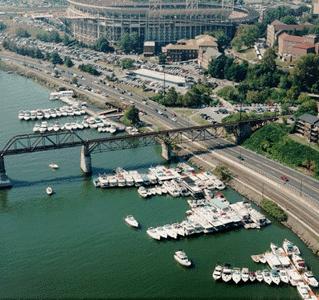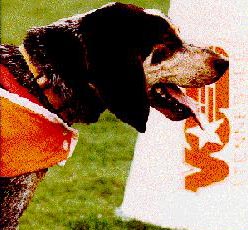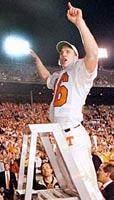Tennessee Traditions
Tennessee Traditions
The "T" in Tennessee
 The famed letter "T" debuted on Tennessee helmets in the fall of 1964 when Doug Dickey took over as head coach. Prior to 1964 the helmets had been white with an orange stripe down the middle. However, there have been 2 exceptions. In coach Bowden Wyatt's final season in 1962, the Vols had orange numerals on the sides of the helmets. In 1963 coach Jim McDonald changed the color of the numbers to black. When Johnny Majors was named head coach in 1977, he had the "T" slightly rounded off and the stripe widened.
The famed letter "T" debuted on Tennessee helmets in the fall of 1964 when Doug Dickey took over as head coach. Prior to 1964 the helmets had been white with an orange stripe down the middle. However, there have been 2 exceptions. In coach Bowden Wyatt's final season in 1962, the Vols had orange numerals on the sides of the helmets. In 1963 coach Jim McDonald changed the color of the numbers to black. When Johnny Majors was named head coach in 1977, he had the "T" slightly rounded off and the stripe widened.
 Coach Dickey also gave life to another Tennessee tradition when he started the Vols running through the "T" formed by the Pride of the Southland Band to begin all home games. Before Dickey became coach, the team's bench was located on the east side of the field close to the dressing room which was near the 50 yard line. Dickey had the team's bench moved to west side, allowing the Vols to come on to the field through a giant "T" formed by the marching band. This remained true until 1983 when the dressing room was moved under the north stands and the "T" changed to form from north to south rather than east to west. The "T" has been formed on the road occasionally, most notably at the Liberty Bowl in Memphis, Vanderbilt Stadium in Nashville, and at the 1986 and 1991 Sugar Bowls in New Orleans.
Coach Dickey also gave life to another Tennessee tradition when he started the Vols running through the "T" formed by the Pride of the Southland Band to begin all home games. Before Dickey became coach, the team's bench was located on the east side of the field close to the dressing room which was near the 50 yard line. Dickey had the team's bench moved to west side, allowing the Vols to come on to the field through a giant "T" formed by the marching band. This remained true until 1983 when the dressing room was moved under the north stands and the "T" changed to form from north to south rather than east to west. The "T" has been formed on the road occasionally, most notably at the Liberty Bowl in Memphis, Vanderbilt Stadium in Nashville, and at the 1986 and 1991 Sugar Bowls in New Orleans.
Nickname
 The University of Tennessee, as the state's land grant university, draws the nickname of its athletic teams ("Volunteers") from the name most associated with the state. Tennessee got the name "The Volunteer State" in the early 19th century when Gen. Andrew Jackson mustered large armies from his home state to fight the Indians and later the British in the Battle of New Orleans. The name stuck when the Mexican War came about and Gov. Aaron Brown issued a call for 2800 men to battle Santa Ana and some 30,000 volunteered! The name "Volunteers" is frequently shortened to "Vols" when describing UT athletic teams.
The University of Tennessee, as the state's land grant university, draws the nickname of its athletic teams ("Volunteers") from the name most associated with the state. Tennessee got the name "The Volunteer State" in the early 19th century when Gen. Andrew Jackson mustered large armies from his home state to fight the Indians and later the British in the Battle of New Orleans. The name stuck when the Mexican War came about and Gov. Aaron Brown issued a call for 2800 men to battle Santa Ana and some 30,000 volunteered! The name "Volunteers" is frequently shortened to "Vols" when describing UT athletic teams.
School Colors
The colors Orange and White were selected by Charles Moore who was a member of the first football team in 1891. A student body later approved by putting it to a vote. The colors were those of the common American Daisy that grew in profusion on The Hill. Players didn't appear in the now-famous orange jerseys until the season opening game in 1922. That game was won over Emory and Henry by a score of 50-0.
Volunteer Navy
 In 1962 former Vol broadcaster George Mooney found a quicker and more exciting way to get to Neyland Stadium other than fighting the notorious Knoxville traffic. Mooney navagated his little runabout down the Tennessee River to the stadium and spawned what would later become known as the "Volunteer Navy." Today, approximatly 200 boats of all shapes and sizes make up this giant floating tailgate party. Tennessee and the University of Washington are the only institutions with stadiums ajacent to bodies of water.
In 1962 former Vol broadcaster George Mooney found a quicker and more exciting way to get to Neyland Stadium other than fighting the notorious Knoxville traffic. Mooney navagated his little runabout down the Tennessee River to the stadium and spawned what would later become known as the "Volunteer Navy." Today, approximatly 200 boats of all shapes and sizes make up this giant floating tailgate party. Tennessee and the University of Washington are the only institutions with stadiums ajacent to bodies of water.
Checkerboard End Zones
A Tennessee trademark from the mid-1960's was reinstated in 1989 with the installation of the orange and white checkerboard end zones on Shields-Watkins Field and continued with the return of grass. The unique design accompanied coach Doug Dickey's arrival in 1964. The colorful and popular end zones were a part of Tennessee football until 1968 when the natural sod was dug out and artificial turf was put in its place. Workers installed the orange and white end zones and the interlocking UT at the 50-yard line in the summer of 1989. They were both completely inlaid with contrasting colored turf rather than painted turf.
Smokey
 The UT Pep Club held a contest in 1953 to select a mascot to represent the school. W.C. Brooks entered "Smokey", his prize-winning coon hound (and native breed of dog to Tennessee) in the contest. At halftime of a 1953 game, all the competing dogs were lined up on the field and introduced over the loudspeakers and the student body cheered for their favorite. Smokey was the last hound introduced. When his name was called out, he barked. The students cheered and Smokey threw his head back and howled. This kept going, and with the whole stadium roaring, Tennessee had found its mascot. Since the original Smokey's reign from 1953-54, there have been 7 other Smokeys'. Smokey II was dognapped by Kentucky students in 1955 and survived a confrontation with the Baylor bear at the 1956 Sugar Bowl. Smokey VI, who suffered from heat exhaustion in 140-degree temperatures in the 1991 UCLA game, was listed on the Vols injury report until he returned later in the season. Smokey is famous for leading the Vols through the "T" prior to each home game.
The UT Pep Club held a contest in 1953 to select a mascot to represent the school. W.C. Brooks entered "Smokey", his prize-winning coon hound (and native breed of dog to Tennessee) in the contest. At halftime of a 1953 game, all the competing dogs were lined up on the field and introduced over the loudspeakers and the student body cheered for their favorite. Smokey was the last hound introduced. When his name was called out, he barked. The students cheered and Smokey threw his head back and howled. This kept going, and with the whole stadium roaring, Tennessee had found its mascot. Since the original Smokey's reign from 1953-54, there have been 7 other Smokeys'. Smokey II was dognapped by Kentucky students in 1955 and survived a confrontation with the Baylor bear at the 1956 Sugar Bowl. Smokey VI, who suffered from heat exhaustion in 140-degree temperatures in the 1991 UCLA game, was listed on the Vols injury report until he returned later in the season. Smokey is famous for leading the Vols through the "T" prior to each home game.
Pride of the Southland Band
The UT band was organized immediatly after the War Between the States when the Universty reopened. Since that time, enrollment in the band program has grown to over 300 students from all colleges of the University. Directior of Bands Gary Sousa heads up a program which has maintained a long-standing reputation as one of the nation's finest musical organizations. The program is divided into several different units. The most famous of these is the marching band. The Pride of the Southland Band appears at all home football games and 3 out-of-town games before more than 850,000 spectators plus millions on television. They have represented the State of Tennessee at the Eisenhower, Johnson, Nixon, Carter, Reagan, Bush, and Clinton Presidential Inaugerations and has appeared at the Rose, Astro-Bluebonnet, Citrus, Gator, Hall of Fame, Liberty, Peach, Fiesta, Cotton, and Sugar Bowls.
Click here to hear a sample of the band playin' "Rocky Top!"
"Rocky Top"
 Nothing gives a Vol fan more pride than hearing "Rocky Top" being played after a Tennessee touchdown or big play. Although its not officially the Tennessee fight song, it is the most well known by fans and foes alike. A bluegrass tune written by Felice and Boudleaux Bryant (certianly no relation to the famous 'Bama coach), the lyrics speak proudly of an east Tennessee mountian home:
Nothing gives a Vol fan more pride than hearing "Rocky Top" being played after a Tennessee touchdown or big play. Although its not officially the Tennessee fight song, it is the most well known by fans and foes alike. A bluegrass tune written by Felice and Boudleaux Bryant (certianly no relation to the famous 'Bama coach), the lyrics speak proudly of an east Tennessee mountian home:
Wish that I was on ol' Rocky Top, down in the Tennessee hills
Ain't no smoggy smoke on Rocky Top, ain't no telephone bills
Once I had a girl on Rocky Top, half-bear the other half cat
Wild as a mink and sweet as soda pop, I still dream about that
Chorus:
Rocky Top, you'll always be
Home sweet home to me
Good Ol' Rocky Top!
Rocky Top, Tennessee
Rocky Top, Tennessee!
Once two strangers climbed ol' Rocky Top, lookin' for a moonshine still
Strangers ain't come down from Rocky Top, reckon they never will
Corn won't grow at all on Rocky Top, dirt's too rocky by far
That's why all the folks on Rocky Top, get their corn from a jar
(Chorus)
I've had years of cramped-up city life, trapped like a duck in a pen
All I know is its a pity-life, can't be simple again.
(Chorus)
